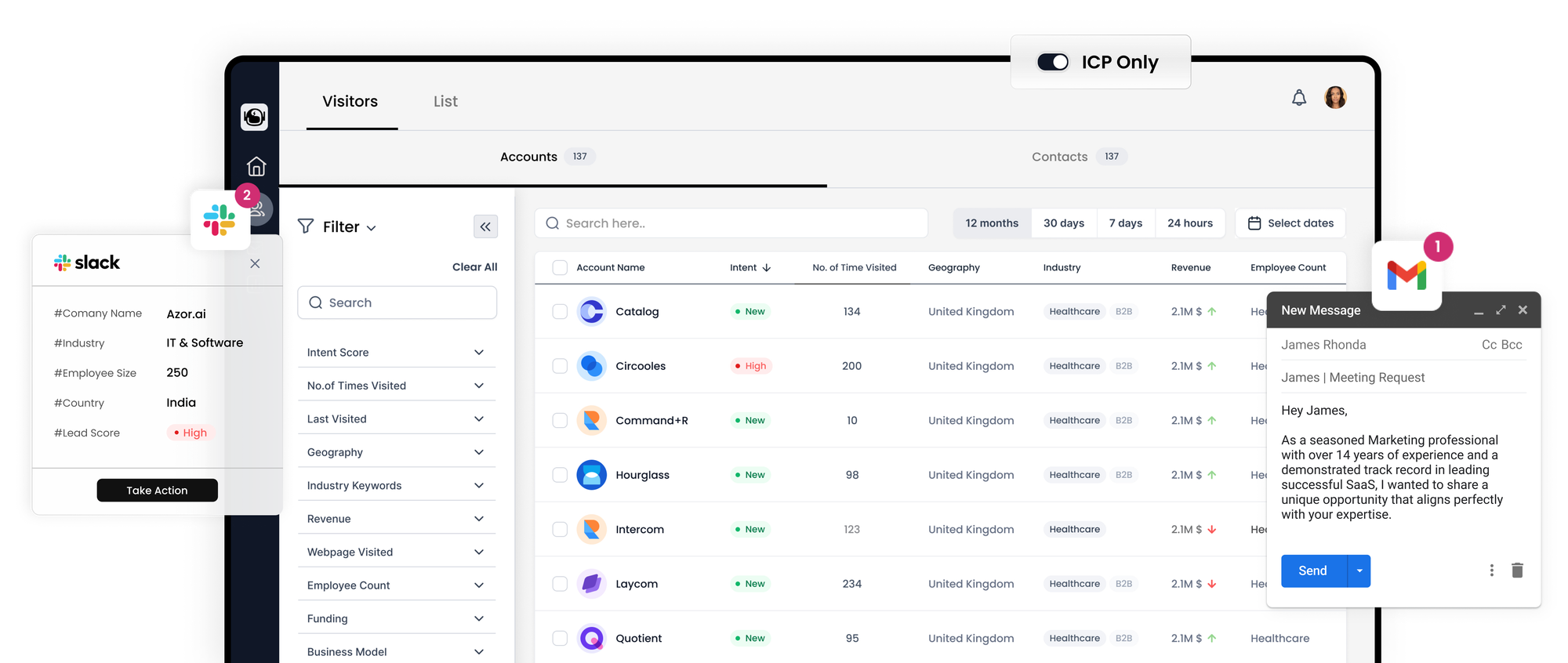Demand Generation Demystified: A Comprehensive Overview

Navigating your business in an ever-changing market landscape can be daunting. While the instinct may be to scale back during uncertain times, the opposite approach is often more beneficial. In a world where people are adapting to new norms and roles, your products and services are more in demand than ever before. The staggering 32% surge in the U.S. eCommerce industry in 2020 underscores the importance of providing content and resources that resonate with your audience's needs.
Understanding Demand Generation
Demand generation entails the creation of marketing and sales programs that employ inbound and lead generation strategies to guide potential buyers through the sales funnel. The ultimate aim is to establish your brand as the trusted go-to solution for addressing your audience's problems, resulting in the generation of high-quality leads for your sales team.
This multifaceted process typically involves:
1. Building brand awareness by educating your audience and addressing their pain points.
2. Leveraging both inbound and outbound marketing strategies to generate leads.
3. Converting leads into sales by positioning your product or service as the ideal problem solver.
4. Continuously engaging with customers even after the purchase, striving to anticipate their future needs.
It is crucial for your marketing and sales teams to collaborate closely within a structured framework, ensuring a deep understanding of buyers' needs at every stage of their journey. Successful demand generation initiatives can yield a remarkable ROI of over 200%.

Demand Generation vs. Lead Generation: Distinguishing Factors
While demand generation and lead generation might appear synonymous at first glance, they serve distinct purposes with some overlap. Demand generation focuses on creating buzz and raising awareness about the availability of your brand's products or services. In the process, you cultivate a target audience, foster brand loyalty, and accumulate a pool of genuinely interested leads. Content for demand generation includes blog articles, social media posts, and branded videos.
Once your audience is informed about your brand and offerings, you transition to lead generation, where the goal is to convert and nurture those leads into paying customers. Lead generation content comprises gated articles, courses, and direct mail campaigns.
Crucial Demand Generation Framework
A well-defined demand generation framework provides structure to your multifaceted marketing and sales activities. While specific structures may vary, a comprehensive framework should encompass the following elements:
1. Planning
Define goals, milestones, target markets, and stakeholders. Develop a strategy to reach your audience effectively.
2. Preparing
Craft strategic messaging and offers to form the basis of your marketing campaign.
3. Executing
Market and promote your demand generation campaign across all relevant channels.
4. Assessing
Analyze reports and data to track progress and optimize your campaign for more qualified leads.
Campaigns serve as the cornerstone of your demand generation strategy, offering insights into your audience's preferences. They assist in lead identification through free tools and content that position your brand as a problem-solving entity. When planning a campaign, outline its goals, objectives, marketing activities, channels, and required resources.
A dedicated team or individuals are essential to manage demand generation efforts, ensuring the seamless execution of your campaign, especially in terms of sales conversion. The size and composition of your team may be influenced by campaign budgets, with smaller brands having one or two specialists, while larger companies operate with full departments. A typical demand generation team may include roles such as Content Manager, Web Manager, Paid Acquisition Manager, Marketing Ops/Automation Specialist, Marketing Lifecycle Manager, Social Media & PR Coordinator, Event & Campaign Manager, and Graphic Designer.
Regardless of the team's size, adopting an account-based marketing approach is beneficial. This approach involves close collaboration between marketing and sales teams to identify, target, and convert high-potential leads.
Crafting an Effective Demand Generation Strategy
The success of your demand generation strategy hinges on how effectively you optimize its core components.
Audience Segmentation
Precise audience segmentation is crucial for allocating resources to the right individuals at the right time. This approach ensures that amidst the noise, your brand delivers messages tailored specifically to your target market. Even with limited data, you can narrow your audience based on factors such as location, industry, and profession.
Brand Awareness
Establishing brand awareness is the initial step in demand generation. It involves creating recognizable and unique branding assets for your product or service. Additionally, developing buyer personas aids in selecting the most effective marketing strategies and channels for reaching your audience.
Inbound Marketing
Inbound marketing occurs when prospects actively search for solutions to their problems and stumble upon your brand organically through search engines. To craft a successful inbound marketing strategy, you must consistently produce content across all channels that educates your market, fosters brand loyalty, and positions your brand as an authority in the field.
Content Marketing
Content marketing revolves around the consistent creation and promotion of content designed to attract leads and boost sales. To deliver customer-centric content at every stage of the journey, it's essential to approach content marketing as a collaborative endeavor.
Sales Enablement
The process of guiding your leads through the funnel until they reach the decision-making stage is critical. Your sales and marketing teams should operate as a cohesive unit, adopting a buyer-centric perspective to close deals and orchestrate an ideal customer journey.
Enhancing Demand Generation
A faltering demand generation strategy not only hampers your business but can also undermine your objectives. Without a well-defined brand awareness plan or buyer persona, attracting website visitors and understanding your audience can become challenging. Ultimately, an ineffective demand generation strategy results in reduced lead conversion rates, diminished client retention, and inaccurate data reporting.
Metrics serve as a valuable tool for assessing what's working, what's essential, and the data and technology driving optimal results. Neglecting to track performance indicators can lead to leads slipping through the cracks, potentially costing you valuable customers.
When measuring demand generation, consider the following metrics:
1. Number of Meetings
Keep track of the number of individuals scheduling meetings with your company to discuss products or services. Although typically measured at the top of the funnel, this metric offers insights into lead interest and quality throughout the process.
2. Number of Opportunities
Monitoring the number of lead opportunities that ultimately convert into paying customers provides clarity on your effectiveness.
3. Average Deal Size
Calculating the dollar value of each customer aids in targeting leads and channels with the highest return on investment.
4. Customer Acquisition Cost
A central goal of demand generation is revenue increase, making it crucial to know the cost of acquiring a customer. This information informs decisions about channels, ad investments, automation, and more, helping gauge your company's sales success.
5. Cost Per Lead
Similar to customer acquisition cost, this metric reveals the expenditure per lead, enabling accurate budget estimation for the entire funnel and preventing overspending.
6. Customer Lifetime Value
Determine the average amount a customer will spend with your company over their lifetime. If improvement is needed, consider enhancing your engagement tactics.
7. Average Sales Cycle Length
Measure the time it takes for prospects to move through each funnel stage. A lengthy conversion process may prompt exploration of alternative sales channels or streamlining to expedite conversions and improve ROI.
8. Revenue Generated Against Budget Investment
This metric assesses the campaign's profitability by subtracting profits from costs, revealing the overall campaign effectiveness.
Exploring the Best Demand Generation Tools
The effectiveness of demand generation strategies relies heavily on the tools you employ. Without the right CRM, email marketing instruments, and analytics platforms, achieving optimal results in inbound marketing campaigns can be a daunting task. As such, we've compiled a list of essential demand generation tools that digital marketers should incorporate into their toolkit.
Lead Scoring and Nurturing
Mere lead collection isn't sufficient. Without the utilization of analytics and lead scoring to identify leads that are primed for sales engagement, you risk missing valuable conversion opportunities. There are automation tools available that facilitate lead modeling, scoring, and nurturing, such as Autopilot. Subsequently, for nurturing these leads, email marketing tools like Mailchimp prove invaluable.
Interactive Content
While static content can effectively convert visitors with compelling copy and content, enhancing content with interactivity can significantly boost engagement. This interactivity can take various forms, including calculators, chatbots, quizzes, or surveys. Research has shown that interactive content can generate twice the conversions compared to static content.
Integration of Events and Webinars
Hosting webinars and other online events can be instrumental in building demand for your products and services. Tools such as Akkroo enable you to track leads and gather data across both physical and digital channels.
Corporate Gifting
Distinguishing your brand and enticing leads to your company can be achieved through thoughtful gestures like sending gift baskets, eGifts, and swag bags. Platforms like Sendoso simplify this process with their gifting platform and services, which have been known to generate returns on campaign investment exceeding 200%.
Contests
Running various types of giveaways, sweepstakes, and photo contests can significantly boost engagement and drive demand generation for your brand. Platforms like Wishpond empower you to create contests across social media, blogs, websites, and mobile apps.
Initiating Demand Generation for Your Business
Businesses exist to generate revenue, and demand generation provides the framework for consistently attracting, converting, and tracking your target audience throughout their entire purchase journey. This approach grants valuable insights into the necessary actions and resources required to achieve your objectives, as well as the identification of relevant performance indicators.
With Sendoso, you can efficiently manage your demand generation activities all in one place. This comprehensive platform enables you to construct a pipeline that effectively engages, acquires, and retains customers. When running a campaign, you can confidently assess the return on investment (ROI) for internal evaluations and share this crucial data with stakeholders.
Ideal for those seeking to enhance their demand generation strategy, Sendoso streamlines the process of generating demand at each pivotal stage, optimizing your sales funnel and delivering an exceptional return on investment.
